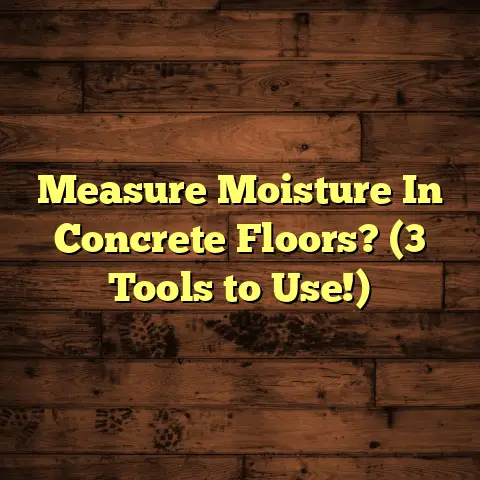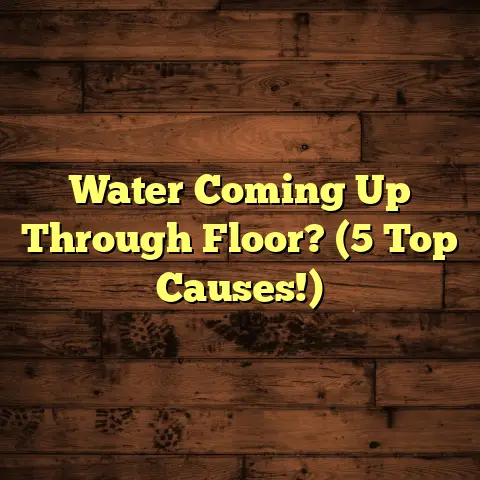Black Spots On Wood? (2 Causes, Quick Cure!)
I’m here to tell you that dealing with black spots
on wood doesn’t have to be a nightmare.
In this
article, I’m going to walk you through the two main
culprits behind those pesky spots and give you some
quick cures to get your wood looking its best again.
Trust me, with a little know-how, you can tackle
this problem head-on and keep your wooden surfaces
in tip-top shape.
Understanding Black Spots on Wood
So, what exactly are these black spots we’re talking
about?
Well, they’re exactly what they sound like:
dark, often irregular spots that appear on the surface
of wood.
They can range in size from tiny pinpricks
to larger, more noticeable blotches.
Now, you might be thinking, “Okay, they’re ugly, but
are they really a big deal?” The answer is: it depends.
Aesthetically, these spots can ruin the look of your
wooden pieces.
Imagine a gorgeous hardwood floor
marred by dark blemishes – not ideal, right?
Functionally, they can indicate a deeper problem,
like moisture damage or wood decay, which can
compromise the integrity of the wood.
A common misconception is that black spots are just
cosmetic issues that can be ignored or covered up
with a bit of stain.
Wrong! Ignoring them can lead
to more significant problems down the line, like
structural damage or the spread of mold.
That’s why
it’s crucial to understand what’s causing those spots
and address the underlying issue.
Cause #1 – Mold and Mildew
Alright, let’s dive into the first major cause of
black spots on wood: mold and mildew.
These
fungi thrive in damp, dark environments, and wood
is their favorite snack.
Think of your bathroom after a hot shower or a damp basement – these are prime breeding grounds for mold and mildew.
What conditions promote mold growth?
- Moisture Levels: Mold needs moisture to survive, so any area with high humidity or water leaks is at risk.
- Ventilation: Poor ventilation traps moisture, creating the perfect environment for mold to flourish.
- Temperature: Mold grows best in warm temperatures, typically between 60°F and 80°F (15°C and 27°C).
Now, how do you tell the difference between mold/
mildew and other types of stains?
Here are a few
tell-tale signs:
- Appearance: Mold and mildew often appear as fuzzy or slimy patches, while regular stains tend to be smoother and more uniform.
- Smell: Mold and mildew have a distinctive musty odor that’s hard to miss.
- Location: Mold and mildew are often found in damp, poorly ventilated areas, while other stains can appear anywhere.
If you spot any of these signs, it’s time to take action!
Step-by-Step Guide: Removing Mold and Mildew
Okay, let’s get down to business.
Here’s how to
kick mold and mildew to the curb:
- Gather Your Supplies:
- White vinegar
- Baking soda
- Spray bottle
- Scrub brush
- Gloves
- Mask
- Eye protection
- Safety First:
- Put on your gloves, mask, and eye protection.
- Open windows and doors for ventilation.
- Prepare Your Cleaning Solution:
- Mix equal parts white vinegar and water in a spray bottle.
- Apply the Solution:
- Spray the affected area thoroughly with the vinegar solution.
- Let it sit for 10-15 minutes to kill the mold and mildew.
- Scrub Away:
- Use a scrub brush to gently scrub the affected area.
- For stubborn spots, make a paste of baking soda and water and apply it to the area before scrubbing.
- Rinse and Dry:
- Rinse the area with clean water.
- Dry the area thoroughly with a clean cloth.
- Repeat if Necessary:
- For severe mold infestations, you may need to repeat the process.
Industry Tip: I’ve found that a product called
“Concrobium Mold Control” works wonders on tough
mold and mildew.
It’s available at most hardware
stores and is safe for use on wood.
Important Note: If you’re dealing with a large
mold infestation (more than 10 square feet), it’s
best to call in a professional mold remediation
company.
They have the expertise and equipment
to safely and effectively remove the mold without
spreading it further.
Cause #2 – Water Damage
Now, let’s talk about the second major cause of
black spots on wood: water damage.
Water is wood’s
worst enemy, and prolonged exposure can lead to
some serious problems, including those dreaded
black spots.
When water penetrates wood, it can cause several things to happen:
- Discoloration: Water can react with the tannins in the wood, causing it to darken and stain.
- Structural Weakening: Water can weaken the wood fibers, making it more susceptible to rot and decay.
- Mold Growth: As we discussed earlier, water creates the perfect environment for mold and mildew to thrive, leading to those black spots.
What are the sources of water damage?
- Spills: Accidental spills are a common cause of water damage, especially on wooden floors and furniture.
- Leaks: Leaky roofs, pipes, or appliances can cause water to seep into wood, leading to hidden damage.
- High Humidity: Excessive humidity can cause wood to absorb moisture from the air, leading to warping, swelling, and discoloration.
What are the indicators of water damage?
- Warping: Water can cause wood to warp or bend out of shape.
- Discoloration: As mentioned earlier, water can cause wood to darken or stain.
- Changes in Texture: Water-damaged wood may feel soft, spongy, or brittle.
- Musty Odor: The presence of mold and mildew often indicates water damage.
How to Treat Water-Damaged Wood
Alright, let’s get to the nitty-gritty of treating water-damaged wood. Here’s a step-by-step guide:
- Identify the Source of the Water:
- Before you can fix the damage, you need to find and stop the source of the water leak or spill.
- Dry the Wood Thoroughly:
- Use towels, fans, or a dehumidifier to dry the affected area as quickly as possible.
- For small areas, you can use a hairdryer on a low setting.
- Remove Damaged Wood:
- If the wood is severely damaged or rotten, you may need to remove it and replace it with new wood.
- Sand the Area:
- Once the wood is dry, sand the affected area to remove any remaining stains or discoloration.
- Start with a coarse grit sandpaper (80-grit) and gradually work your way up to a finer grit (220-grit).
- Refinish the Wood:
- After sanding, you’ll need to refinish the wood to protect it from future damage.
- Apply a stain that matches the original color of the wood.
- Follow with a coat of sealant or varnish to protect the wood from moisture.
Preventive Measures
Of course, the best way to deal with water damage
is to prevent it from happening in the first place.
Here are a few tips:
- Clean Up Spills Immediately: Wipe up any spills as soon as they happen to prevent water from soaking into the wood.
- Fix Leaks Promptly: Address any leaks in your roof, pipes, or appliances as soon as possible.
- Control Humidity: Use a dehumidifier to keep humidity levels in your home below 50%.
- Use Wood Sealants: Apply a wood sealant to protect your wooden surfaces from moisture.
Industry Secret: I always recommend using a
product called “Thompson’s WaterSeal” on exterior
wood surfaces like decks and fences.
It’s a great
way to protect your wood from the elements and
prevent water damage.
Quick Cure and Prevention Techniques
Alright, let’s recap the quick cures for those pesky black spots and talk about how to prevent them from coming back.
Quick Cures:
- Mold/Mildew:
- Clean the affected area with a solution of white vinegar and water.
- Scrub with a brush and rinse thoroughly.
- Dry the area completely.
- Water Damage:
- Dry the wood thoroughly.
- Sand the affected area to remove stains and discoloration.
- Refinish the wood with a stain and sealant.
Prevention Techniques:
- Regular Cleaning:
- Clean your wooden surfaces regularly with a damp cloth to remove dirt and grime.
- Avoid using harsh chemicals or abrasive cleaners, as they can damage the wood.
- Proper Humidity Control:
- Use a dehumidifier to keep humidity levels in your home below 50%.
- Ensure proper ventilation in bathrooms and kitchens.
- Wood Sealants:
- Apply a wood sealant to protect your wooden surfaces from moisture.
- Reapply sealant every few years, or as needed.
- Promptly Address Damage:
- If you notice any signs of water damage or mold growth, address the issue immediately to prevent it from escalating.
My Personal Tip: I always keep a close eye on
the areas in my home that are prone to moisture,
like bathrooms and basements.
Regular inspections
can help you catch problems early before they turn
into major headaches.
Conclusion
So, there you have it!
Black spots on wood might
seem like a minor annoyance, but they can indicate
more significant problems if left untreated.
By
understanding the causes – mold/mildew and water
damage – and applying the right cures, you can keep
your wooden surfaces looking beautiful and ensure
they last for years to come.
Remember, proactive care is key!
Regular cleaning,
proper humidity control, and prompt attention to any
signs of damage will go a long way in preventing
those pesky black spots from reappearing.
Take pride in your wooden surfaces, and they’ll
reward you with their beauty and longevity.
With
the knowledge and techniques I’ve shared in this
article, you’re well-equipped to tackle any black spot
challenges that come your way.
Keep your wood happy, and it’ll keep you happy!
Now go forth and conquer those black spots!
You
got this!





